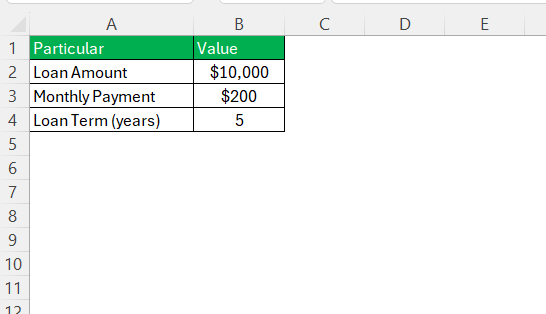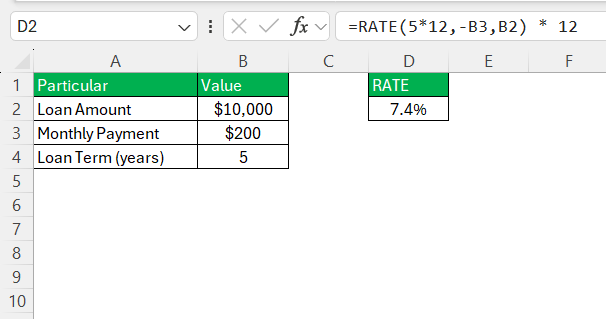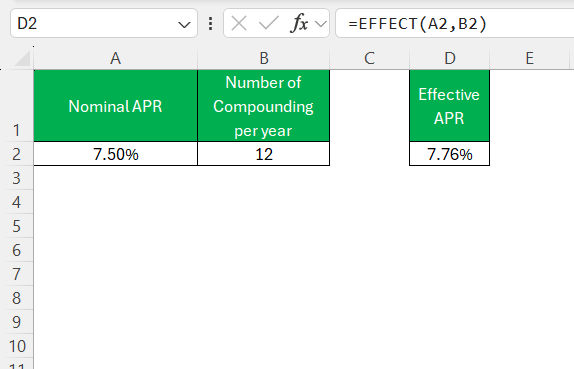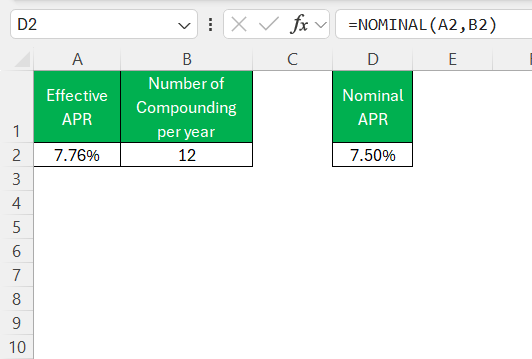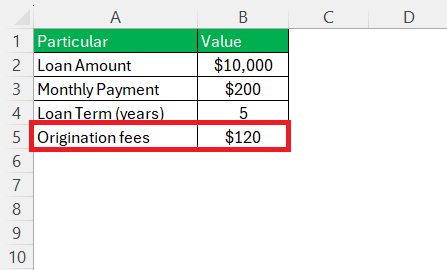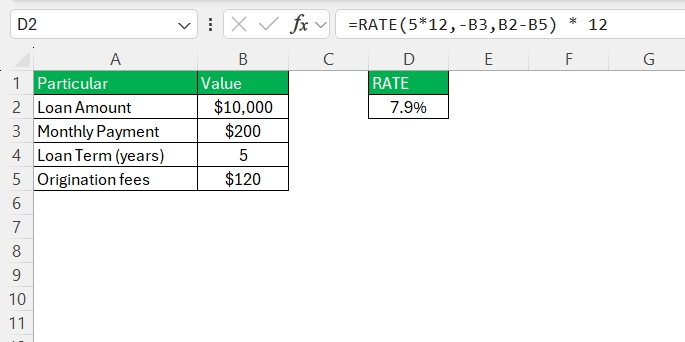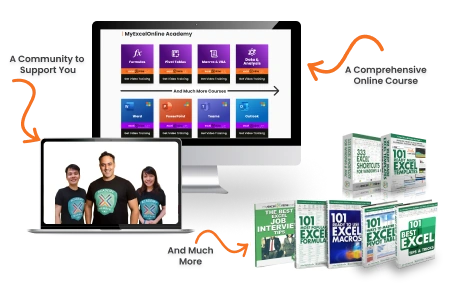When working with financial data in Excel, one of the key calculations I often need is the Annual Percentage Rate (APR). Whether I’m analyzing loan repayments, credit card interest, or mortgage rates, knowing how to find APR in Excel makes my financial assessments much more efficient. In this article, I’ll walk you through how to find apr and how it differs from other interest rates, and the steps to calculate it in Excel.
Key Takeaways:
- Excel simplifies APR calculations, making financial analysis more efficient.
- The RATE function determines APR based on loan payments and terms.
- The EFFECT function converts nominal rates to effective APR for better comparisons.
- Including fees in calculations provides a more accurate borrowing cost.
- Proper data organization in Excel ensures accuracy and minimizes errors.
Table of Contents
Introduction
Understanding APR and Its Importance
The Annual Percentage Rate (APR) is a critical financial metric that reflects the cost of borrowing money on an annual basis, inclusive of interest and additional fees. APR provides a clear picture of what a loan or credit will cost over a year, allowing consumers to compare different financial products effectively. For mortgages, consumer loans, credit cards, and more, APR serves as a benchmark for consumers to make informed financial decisions.
APR is not just the interest rate; it adds a layer of transparency by including fees such as underwriting or origination fees. As such, APR often presents a more comprehensive understanding of the borrowing cost than stand-alone interest rates. Understanding APR is an essential step in ensuring financial literacy when navigating loans and credit products.
Why Use Excel for APR Calculations?
Excel is a powerful tool for managing data and performing calculations, making it an excellent choice for calculating APR. Why, you ask? For starters, Excel can handle complex formulas and large volumes of data without breaking a sweat. It allows you to easily adjust and tweak numbers, which is particularly handy if you’re comparing different loans or financial products.
Another reason to use Excel is the time efficiency it offers. Calculating APR manually for multiple loans or credit cards would be a time-consuming task. However, with Excel, once you’ve set up your formula, you can reuse it as often as needed. Additionally, Excel minimizes the risk of human error in calculations, ensuring accuracy provided the setup is correct.
Using Excel also opens the door to leveraging AI tools that integrate seamlessly. These tools can suggest formulas, automate calculations, and even provide insights into critical data points for your APR calculations. This combination of traditional Excel functions and AI-driven insights ensures a more efficient calculation process that can save both time and effort.
Setting Up Your Excel Sheet for APR Calculations
Preparing Your Data Inputs
Before calculating APR in Excel, it’s essential to set up your spreadsheet by organizing all necessary data inputs. Properly preparing your data will streamline the calculation process and enhance accuracy. Here’s how to proceed:
- Loan Amount: Begin by entering the total amount borrowed in one column. This figure should represent the principal amount of the loan without any adjustments for interest or fees.
- Interest Rate: Input the nominal annual interest rate associated with the loan. This rate is typically provided by the lender and should be expressed as a decimal in order to be used in Excel calculations.
- Loan Term: Determine the length of time over which the loan will be repaid. Enter this information in years, as APR calculations commonly require annualized figures.
By organizing these inputs in distinct, clearly labeled columns, you lay the groundwork for an accurate and efficient APR calculation. Ensuring that your data is comprehensive and organized will allow you to leverage Excel’s functions effectively, maintain consistency across calculations, and reduce the risk of errors. Proper preparation of your data inputs is the first step to simplifying the often complex task of financial analysis.
Common Methods on How to Find APR in Excel
Using the RATE Function with Examples
The RATE function in Excel is a versatile tool for calculating the interest rate per period needed to pay off a loan or achieve a future investment value, based on given payment amounts over specified periods. Here’s a focused look at how to apply this function, with concrete examples.
The basic syntax for the RATE function is:
=RATE(nper, pmt, pv, [fv], [type], [guess])
- nper: Total number of payment periods in an investment or loan.
- pmt: Payment made each period; it cannot change over the life of the investment or loan.
- pv: Present value or total amount the future payments are worth now.
- fv (optional): Future value or cash balance desired after the last payment.
- type (optional): Payment timing; 0 indicates end of period, 1 indicates beginning.
- guess (optional): Initial guess for what the rate will be.
For instance, if I have a 5-year loan of $10,000 with monthly payments of $200, I enter:
=RATE(60, -200, 10000) * 12
This returns the APR.
The EFFECT Function Explained
The EFFECT function in Excel is crucial for calculating the effective annual interest rate, particularly when dealing with loans that have compounding periods more frequent than annually. This function provides a more accurate representation of the true cost of borrowing, allowing for better comparisons across financial products.
Here’s the syntax for the EFFECT function:
=EFFECT(nominal_rate, npery)
- nominal_rate: This is the nominal interest rate, expressed as a decimal. Ensure that you divide the nominal rate by 100 to convert it from a percentage to a decimal.
- npery: The number of compounding periods per year. For instance, use 12 for monthly compounding or 4 for quarterly compounding.
Consider a scenario where you have a nominal APR of 7.5% with monthly compounding. You would input the formula as:
=EFFECT(7.5%, 12)
The result is the effective APR, providing a clearer picture of your annual borrowing costs by accounting for the effect of compound interest. The EFFECT function is indispensable for anyone looking to understand the true annual rate of loans or investments with more frequent compounding intervals. It ensures a level playing field for comparison by turning nominal rates into their effective counterparts, thereby revealing the actual cost over an annual period.
This insight is valuable when comparing different financial products or assessing the real impact of compounding on borrowed funds.
Using the NOMINAL Function
Sometimes, I need to convert the APR into a nominal rate. The NOMINAL function helps with this:
=NOMINAL(effect_rate, npery)
Where effect_rate is the effective interest rate, and npery is the number of compounding periods per year.
Advanced Tips for Precision
Factoring in Fees and Charges
When calculating APR, incorporating fees and charges is essential for an accurate representation of the loan’s total cost. These fees, often overlooked, can significantly impact the effective interest rate. Here’s how to properly factor them in:
STEP 1: Begin by cataloging all upfront costs associated with the loan. Common fees include origination fees, application processing fees, and underwriting fees. These should be clearly detailed in the loan agreement.
STEP 2: In Excel, subtract the total fees from the principal amount to determine the effective loan amount you receive. This adjusted principal is crucial for calculating an accurate APR.
Use the adjusted loan amount as the present value (pv) in the RATE function. This ensures the calculation reflects the actual funds available to you, not just the nominal loan amount.
Excel Sample Formula:
=RATE(nper, pmt, original_principal – total_fees) * 12
If the loan includes future costs, like periodic maintenance fees, they should be factored into the cash flows, ensuring the comprehensive cost is reflected in your APR calculation.
By meticulously incorporating all fees and charges into your APR calculations, you gain a clearer, more comprehensive understanding of the true cost of borrowing. This comprehensive approach helps in comparing different loan offers effectively, equipping you with the information needed to make informed financial decisions.
FAQs
1. What is the difference between APR and the interest rate?
APR includes both the interest rate and additional fees, providing a more accurate picture of the loan’s true cost. The interest rate only reflects the cost of borrowing without considering fees. Comparing APR rather than just the interest rate ensures a better understanding of overall expenses.
2. How does the RATE function calculate APR in Excel?
The RATE function determines the periodic interest rate required to repay a loan, which is then annualized to find APR. It considers factors like the number of payment periods, loan amount, and monthly payment. Multiplying the result by 12 converts the monthly rate into an annual percentage.
3. Why use the EFFECT function for APR calculations?
The EFFECT function helps when dealing with compounding interest, as it converts nominal rates to effective annual rates. This ensures fair comparisons between financial products with different compounding periods. It is useful for evaluating credit cards, mortgages, and other loans with frequent compounding.
4. How do fees affect APR calculations?
Fees increase the total cost of borrowing, making the effective interest rate higher than the stated interest rate. Subtracting fees from the loan principal before applying the RATE function gives a more accurate APR. This method ensures that all hidden costs are considered in financial decisions.
5. What are common mistakes when calculating APR in Excel?
Using incorrect payment periods, ignoring fees, or misapplying functions like RATE or EFFECT can lead to errors. Ensuring all inputs are in the correct format—such as decimal interest rates and consistent time units—helps maintain accuracy. Organizing data properly in Excel also reduces calculation mistakes.
John Michaloudis is a former accountant and finance analyst at General Electric, a Microsoft MVP since 2020, an Amazon #1 bestselling author of 4 Microsoft Excel books and teacher of Microsoft Excel & Office over at his flagship MyExcelOnline Academy Online Course.

